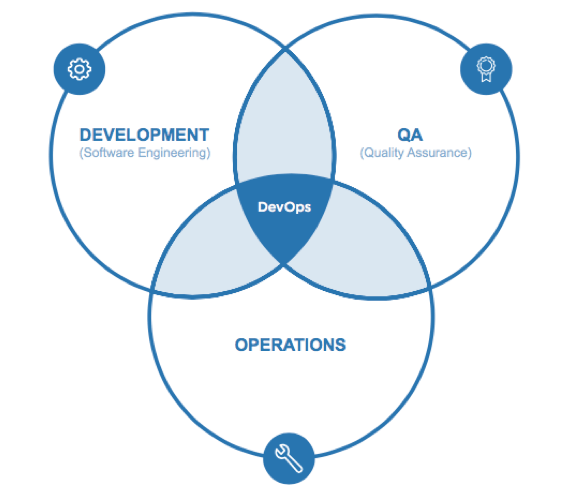DevOps and cloud computing are linked. This fact is well understood by organizations that stand up SaaS clouds or build applications in the cloud.
The core component of this relationship is value through agility. DevOps provides the automation behind agile methods. Traditional target platforms require weeks or months of planning for the hardware and software required. Even with virtualization, the automated provisioning of those resources can’t typically be done on demand.
When it comes to implementing DevOps in concert with the cloud, there are a few core principles to understand and incorporate.
Get AWS DevOps Real-time Projects Online Training in Hyderabad

* There should be a continuous process that includes all aspects of development, testing, staging, deployment, and operations. There should be no time where parts of the process can’t be fully automated. This includes self- or auto-provisioning target platform resources.
* Major and minor changes to applications, from development to operations, should typically occur in less than one day. Moreover, the deployment platform should support almost unlimited provisioning of resources.
* The entire process can exist on premises, in the cloud, or in hybrid configurations. Moreover, the use of multiple cloud brands, such as AWS, Google, and Microsoft, should be supported, as well as public and private cloud models.
For organizations already practicing DevOps, the following steps will help guide them toward successful cloud adoption.
A DevOps strategy for success with the cloud
Here’s how to extend your DevOps strategy to accommodate the cloud.
Step 1: Understand your own requirements
While this would seem to be a logical first step in moving to DevOps and the cloud, many enterprises often neglect the planning required.
First, you need to understand the solution patterns of the applications you’re looking to build. For instance, will there be data-intensive or processor-intensive applications, or a mix? Will the applications require any special hardware or software requirements, such as HPC or IPC middleware? Finally, consider security, performance, monitoring, governance — basically all of the core details that make up your requirements shopping list.
Keep in mind that you’re not looking to solve the problem of a single application, but selecting a core cloud architecture that can accommodate most of the applications that will be built, tested, and deployed using your DevOps automation solution. Also, keep in mind that it’s okay to use multiple target clouds for deployment. Indeed, multiple options for deployment allow you to define and redefine as clouds mature and the prices of public cloud services rise and fall.
Step 2: Define your DevOps process
What is the process that you want to employ, and for what end result? DevOps processes are very different from organization to organization. However, core to this is an understanding of how things are changing. Table 1 shows the old way of doing development and deployment versus the new way of using DevOps and the cloud.
Table 1: As DevOps and cloud become the primary way to build and deploy software, we must understand what’s changed.
| The old way | The new way |
|---|---|
|
Software is build and shipped |
Services are run and managed |
|
Development of features is done |
Services are never done until turned off |
|
Product owners focus only on features |
Product owners own operational results along with the product feature set |
|
Each silo owns its own area |
All groups focus on end user satisfaction |
|
Dev must go through ops to get work done |
Ops enables Dev to get work done |
|
Ops monitors apps |
Ops provides Dev with tools to operate apps |
|
Reactive monitoring / Ops |
Proactive monitoring / Dev |
|
Customers are isolated from each other |
Multi-tenancy and shared resources |
|
Application services share common platform and infrastructure |
Distributed services on isolated instances, hardware independence |

Under the new way, for the most part, we are delivering not software, but services. In the old way, development had to go through operations to get any work done using the traditional model; but now, with DevOps and the cloud, Ops enables Dev to get work done. In the old way, there was reactive monitoring for operations, versus the newer proactive monitoring for DevOps and the cloud.
It’s important to understand which traditional approaches to development and operations to let go of as you move to DevOps and the cloud. In most instances, this means blowing up traditional waterfall methods and tools. Now we must figure out the least latent approach to the DevOps process, including consideration of the target platform, which will likely be private or public clouds. To break this process down further:
Also Read: How to Deploying Docker Containers Using AWS CodePipeline for DevOps
1. Continuous development is the ability to build applications or services and, at the press of a button, have the solution tested, integrated, staged, deployed, and pushed into operations within the target cloud platform or choice. During any step in this automated process, the solution may be returned to the developer for correcting any problem found. This allows developers to operate near the speed of need, which is the ability to respond to business user requests in near real time.
2. Continuous testing is an automated testing process that is coupled with continuous development, including unit and system tests that are automated for the applications as they move through the DevOps process. Testing can occur on premises or within public clouds.
Best practices for maintaining testing framework using Java Selenium webdriver
What is Web Application Testing? Important points to consider while Testing
3. Continuous integration is a development practice that provides for the integration of code into a shared repository several times a day. Each check-in is then verified by an automated build, allowing teams to detect problems early, and is also coupled with continuous testing and continuous development.
4. Continuous deployment means that each change that passes the automated testing and integration procedures automatically moves to production. Public clouds are typically the target platform, which are able to accept integrated and tested code and keep it in sync with the rest of the DevOps processes, no matter where the automated tools exist.
Step 3: Select and test tools
The tools selected must work with public cloud services. In most instances, they also need to work with private cloud services so enterprises can deploy to a hybrid cloud. Thus, the cloud-enabled DevOps package needs an interface with the cloud provider’s management system.
Recommend to Read
Top 5 Most In-Demand Programming Languages of 2023
AWS DevOps Job Support from India by 9 yrs. DevOps Expert
AWS DevOps Real-time Projects Online Training in Hyderabad
9 QA Automation Trends of 2023
Learn Automation Testing – Become a great Selenium Testing Engineer
Best Selenium C# Training Online with Live Project Hyderabad
Best Selenium Training Online with Live Project in Hyderabad
Coding is the new literacy: 5 programming languages to master for high paid Jobs
Related Articles
Master Your RPA Developer Interview with Real-World Scenario Questions
Preparing for a Senior RPA Developer interview can be challenging, especially when it involves real-world scenarios. To help you stand out, we’ve...
Top 15 RPA Developer Interview Q & A by Senior RPA Dev
Preparing for a Senior RPA Developer Interview? As the demand for automation continues to rise, so does the need for skilled RPA (Robotic Process...
Complete Process of Document Understanding in RPA UiPath
Unlocking the Power of Document Understanding in UiPath In today's fast-paced world, businesses handle a plethora of documents daily. From invoices...
Unlocking the Power of UiPath AI Units: Your Essential Guide
In the realm of automation, UiPath stands out with its innovative AI Units pricing model, designed to empower businesses of all sizes to streamline...
RPA Lifecycle: Ultimate Guide for UiPath Development Success
In the rapidly evolving landscape of Robotic Process Automation (RPA), understanding the RPA UiPath Lifecycle is crucial for both new and seasoned...
Evaluate and Retrieve Data using API and Validate in SAP System using UiPath
Discover the Power of APIs with UiPath: Simplify Your Data Validation in SAP Systems! Are you ready to unlock the full potential of your data?...
